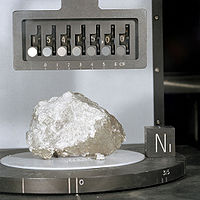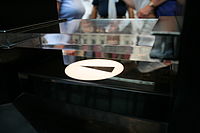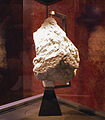- Moon rock
-
Moon rock describes rock that formed on the Earth's moon. The term is also loosely applied to other lunar materials collected during the course of human exploration of the Moon.
The rocks collected from the Moon are measured by radiometric dating techniques. They range in age from about 3.16 billion years old for the basaltic samples derived from the lunar maria, up to about 4.5 billion years old for rocks derived from the highlands.[1] Based on the age dating technique of "crater counting," the youngest basaltic eruptions are believed to have occurred about 1.2 billion years ago,[2] but scientists do not possess samples of these lavas. In contrast, the oldest ages of rocks from the Earth are between 3.8 and 4.28 billion years old.
There are currently three sources of Moon rocks on Earth: 1) those collected by US Apollo missions; 2) samples returned by the Soviet Union Luna missions; and 3) rocks that were ejected naturally from the lunar surface by cratering events and subsequently fell to Earth as lunar meteorites. During the six Apollo surface excursions, 2,415 samples weighing 382 kg (842 lb) were collected, the majority by Apollo 15, 16, and 17. The three Luna spacecraft returned with an additional 0.32 kg (0.7 lb) of samples. Since 1980, over 120 lunar meteorites representing about 60 different meteorite fall events (none witnessed) have been collected on Earth, with a total mass of over 48 kg. About one third of these were discovered by US and Japanese teams searching for Antarctic meteorites (e.g., ANSMET), with most of the remainder having been discovered by collectors in the desert regions of northern Africa and Oman.
Almost all lunar rocks are depleted in volatiles (such as potassium or sodium) and are completely lacking in the minerals found in Earth's water. In some regards, lunar rocks are closely related to Earth's rocks in their composition of the element oxygen. The Apollo moon rocks were collected using a variety of tools, including hammers, rakes, scoops, tongs, and core tubes. Most were photographed prior to collection to record the condition in which they were found. They were placed inside sample bags and then a Special Environmental Sample Container for return to the Earth to protect them from contamination. In contrast to the Earth, large portions of the lunar crust appear to be composed of rocks with high concentrations of the mineral anorthite. The mare basalts have relatively high iron values. Furthermore, some of the mare basalts have very high levels of titanium (in the form of ilmenite). A new mineral found on the Moon, armalcolite, was named for the three astronauts on the Apollo 11 mission: Armstrong, Aldrin, and Collins.
Contents
Curation and availability
 Genesis Rock returned by the Apollo 15 mission.
Genesis Rock returned by the Apollo 15 mission.
Lunar
MissionSample
ReturnedYear Apollo 11 22 kg 1969 Apollo 12 34 kg 1969 Apollo 14 43 kg 1971 Apollo 15 77 kg 1971 Apollo 16 95 kg 1972 Apollo 17 111 kg 1972 Luna 16 101 g 1970 Luna 20 55 g 1972 Luna 24 170 g 1976 The main repository for the Apollo moon rocks is the Lunar Sample Building at the Lyndon B. Johnson Space Center in Houston, Texas. For safe keeping, there is also a smaller collection stored at Brooks Air Force Base in San Antonio, Texas. Most of the rocks are stored in nitrogen to keep them free of moisture. They are only handled indirectly, using special tools.
Moon rocks collected during the course of lunar exploration are currently considered priceless. In 1993, three small fragments from Luna 16, weighing 0.2 g, were sold for US$ 442,500. In 2002, a safe, containing minute samples of lunar and Martian material, was stolen from the Lunar Sample Building. The samples were recovered; in 2003, during the court case, NASA estimated the value of these samples at about $1 million for 285 g (10 oz) of material. Moon rocks in the form of lunar meteorites, although expensive, are widely sold and traded among private collectors.
Goodwill moon rocks
See also: Stolen and missing moon rocksNear the end of the third and final moonwalk and what would be the last moonwalk of the Apollo program, Apollo 17 astronauts Eugene Cernan and Harrison Schmitt picked up a rock (later labeled sample 70017[3]) and made a special dedication to the young people of Earth and "picked up a very significant rock, typical of what we have here in the valley of Taurus-Littrow... composed of many fragments, of many sizes, and many shapes, probably from all parts of the Moon, perhaps billions of years old. " Then President Richard Nixon ordered the distribution of fragments of that rock to 135 foreign heads of state, the 50 U.S. states and its provinces. The fragments were presented encased in an acrylic sphere, mounted on a wood plaque which included the recipients flag which had also flown aboard Apollo 17.[4]
At least one of these was later stolen, sold, and recovered.[5] Other samples went to selected museums, including the National Air and Space Museum, the Kansas Cosmosphere and Space Center, the Washington State Historical Society, and the Ontario Science Centre. The Tribune Tower in Chicago has a small piece in a display case facing Michigan Ave. The Space Window in Washington National Cathedral incorporates a small moon rock within its stained glass. NASA says that almost 295 kilograms (650 lb) of the original 382 kilograms (840 lb) of samples are still in pristine condition in the vault at Johnson Space Center.
NASA has also made a number of educational packs comprising a disc of six small rock and soil samples in a lucite disc and a pack of thin petrological sections. They are available for exhibition and educational purposes in many countries, including Great Britain, where the samples are kept by the Science and Technology Facilities Council.
Classification
Moon rocks fall into two main categories, the ones found in the lunar highlands (terrae) or the maria. The terrae consist dominantly of mafic plutonic rocks. Regolith breccias with similar protoliths are also common. Mare basalts come in three distinct series in direct relation to their chemistry: high-Ti basalts, low-Ti basalts, and Very Low-Ti (VLT) basalts.
Highlands lithologies
Processing facility in Lunar Sample Building at JSC Slice of moon rock at the National Air and Space Museum in Washington, DC
Slice of moon rock at the National Air and Space Museum in Washington, DC
Mineral composition of Highland rocks Plagioclase Pyroxene Olivine Ilmenite Anorthosite 90% 5% 5% 0% Norite 60% 35% 5% 0% Troctolite 60% 5% 35% 0% Mineral composition of mare basalts[citation needed] Plagioclase Pyroxene Olivine Ilmenite High titanium content 30% 54% 3% 18% Low titanium content 30% 60% 5% 5% Very low titanium content 35% 55% 8% 2% Common lunar minerals Mineral Elements Lunar rock appearance Plagioclase feldspar Calcium (Ca)
Aluminium (Al)
Silicon (Si)
Oxygen (O)White to transparent gray; usually as elongated grains. Pyroxene Iron (Fe),
Magnesium (Mg)
Calcium (Ca)
Silicon (Si)
Oxygen (O)Maroon to black; the grains appear more elongated in the maria and more square in the highlands. Olivine Iron (Fe)
Magnesium (Mg)
Silicon (Si)
Oxygen (O)Greenish color; generally, it appears in a rounded shape. Ilmenite Iron (Fe),
Titanium (Ti)
Oxygen (O)Black, elongated square crystals. Primary igneous rocks in the lunar highlands compose three distinct groups: the ferroan anorthosite suite, the magnesian suite, and the alkali suite.
Lunar breccias, formed largely by the immense basin-forming impacts, are dominantly composed of highland lithologies because most mare basalts post-date basin formation (and largely fill these impact basins).
The ferroan anorthosite suite consists almost exclusively of the rock anorthosite (>90% calcic plagioclase) with less common anorthositic gabbro (70-80% calcic plagioclase, with minor pyroxene). The ferroan anorthosite suite is the most common group in the highlands, and is inferred to represent plagioclase flotation cumulates of the lunar magma ocean, with interstitial mafic phases formed from trapped interstitial melt or rafted upwards with the more abundant plagioclase framework. The plagioclase is extremely calcic by terrestrial standards, with molar anorthite contents of 94-96% (An94-96). This reflects the extreme depletion of the bulk moon in alkalis (Na, K) as well as water and other volatile elements. In contrast, the mafic minerals in this suite have low Mg/Fe ratios that are inconsistent with calcic plagioclase compositions. Ferroan anorthosites have been dated using the internal isochron method at "circa" 4.4 Ga.
The magnesian suite (or "mg suite") consists of dunites (>90% olivine), troctolites (olivine-plagioclase), and gabbros (plagioclase-pyroxene) with relatively high Mg/Fe ratios in the mafic minerals and a range of plagioclase compositions that are still generally calcic (An86-93). These rocks represent later intrusions into the highlands crust (ferroan anorthosite) at round 4.3-4.1 Ga. An interesting aspect of this suite is that analysis of the trace element content of plagioclase and pyroxene require equilibrium with a KREEP-rich magma, despite the refractory major element contents.
The alkali suite is so-called because of its high alkali content -- for moon rocks. The alkali suite consists of alkali anorthosites with relatively sodic plagioclase (An70-85), norites (plagioclasse-orthopyroxene), and gabbronorites (plagioclase-clinopyroxene-orthopyroxene) with similar plagioclase compositions and mafic minerals more iron-rich than the magnesian suite. The trace element contents of these minerals also indicates a KREEP-rich parent magma. The alkali suite spans an age range similar to the magnesian suite. Lunar granites are relatively rare rocks that include diorites, monzodiorites, and granophyres. They consist of quartz, plagioclase, orthoclase or alkali feldspar, rare mafics (pyroxene), and rare zircon. The alkali feldspar may have unusual compositions unlike any terrestrial feldspar, and they are often Ba-rich. These rocks apparently form by the extreme fractional crystallization of magnesian suite or alkali suite magmas, although liquid immiscibility may also play a role. U-Pb date of zircons from these rocks and from lunar soils have ages of 4.1-4.4 Ga, more or less the same as the magnesian suite and alkali suite rocks. In the 1960s, NASA researcher John A. O'Keefe and others linked lunar granites with tektites found on Earth although many researchers refuted these claims. According to one study, a portion of lunar sample 12013 has a chemistry that closely resembles javanite tektites found on Earth.
Lunar breccias range from glassy vitrophyre melt rocks, to glass-rich breccia, to regolith breccias. The vitrophyres are dominantly glassy rocks that represent impact melt sheets that fill large impact structures. They contain few clasts of the target lithology, which is largely melted by the impact. Glassy breccias form from impact melt that exit the crater and entrain large volumes of crushed (but not melted) ejecta. It may contain abundant clasts that reflect the range of lithologies in the target region, sitting in a matrix of mineral fragments plus glass that welds it all together. Some of the clasts in these breccias are pieces of older breccias, documenting a repeated history of impact brecciation, cooling, and impact. Regolith breccias resemble the glassy breccias but have little or no glass (melt) to weld them together. As noted above, the basin-forming impacts responsible for these breccias pre-date almost all mare basalt volcanism, so clasts of mare basalt are very rare. When found, these clasts represent the earliest phase of mare basalt volcanism preserved.
Mare basalts
Mare basalts are named for their frequent rate of constituting a large portion of the lunar maria; they are made of mare basalts, which are like terrestrial basalts but have many important differences. The basalts show a large negative europium anomaly. Extraordinary potassium content can be found in a specific basalt, the so-called VHK (Very High K) basalt.
Stolen and missing moon rocks
Because of their rarity, and the difficulty of obtaining more, moon rocks are celebrities amongst stones. They have been targets of vandalism, and many have gone missing or were stolen.
Gallery
-
Lunar Ferroan Anorthosite #60025 (Plagioclase Feldspar). Collected by Apollo 16 from the Lunar Highlands near Descartes Crater. This sample is currently on display at the National Museum of Natural History in Washington, DC
-
Samples in Lunar Sample Building at JSC
See also
- Geology of the Moon
- Stolen and missing moon rocks
- Lunar Receiving Laboratory
- Lunar soil
- Lunar regolith simulant
- Lunar meteorite
- Lunar ice
- Helium-3
References
Cited references
- ^ James Papike, Grahm Ryder, and Charles Shearer (1998). "Lunar Samples". Reviews in Mineralogy and Geochemistry 36: 5.1–5.234.
- ^ H. Hiesinger, J. W. Head, U. Wolf, R. Jaumanm, and G. Neukum, H. (2003). "Ages and stratigraphy of mare basalts in Oceanus Procellarum, Mare Numbium, Mare Cognitum, and Mare Insularum". J. Geophys. Res. 108: 5065. Bibcode 2003JGRE..108.5065H. doi:10.1029/2002JE001985.
- ^ Astromaterials Research & Exploration Science. "70017 Ilmenite Basalt". NASA. http://curator.jsc.nasa.gov/lunar/lsc/70017.pdf.
- ^ "Where are the Apollo 17 Goodwill Moon Rocks?". Collect Space. http://www.collectspace.com/resources/moonrocks_goodwill.html.
- ^ "US returns moon rock to Honduras". BBC News. September 23, 2003. http://news.bbc.co.uk/2/hi/americas/3133570.stm. Retrieved May 13, 2010.
General references
- Marc Norman (April 21, 2004). "The Oldest Moon Rocks". Planetary Science Research Discoveries. http://www.psrd.hawaii.edu/April04/lunarAnorthosites.html.
- Paul D. Spudis, The Once and Future Moon, Smithsonian Institution Press, 1996, ISBN 1-56098-634-4.
- Louis Varricchio,Inconstant Moon, Xlibris Books, 2006, ISBN 1-59926-393-9.
External links
- Rocks & Soils from the Moon — Johnson Space Center
- Apollo Geology Tool Catalog
- Lunar meteorites — Washington University, Department of Earth and Planetary Sciences
- Lunar Samples Lunar and Planetary Institute
- Articles about Moon rocks in Planetary Science Research Discoveries educational journal
- Where Today are the Apollo 11 Lunar Sample Displays? collectSPACE
- Where Today are the Apollo 17 Goodwill Moon Rocks? collectSPACE
The Moon Physical features 
Orbit Lunar surface - Selenography
- Near side
- Far side
- Lunar mare
- (List)
- Craters
- (List)
- Mountains
- Valleys
- South Pole – Aitken basin
- Shackleton crater
- Water
- Soil
- Peak of eternal light
- Space weathering
- Transient lunar phenomenon
Lunar science Exploration Other topics - See also Solar System
- Natural satellite
Categories:- Apollo program
- Lunar science
- Petrology
-
Wikimedia Foundation. 2010.







